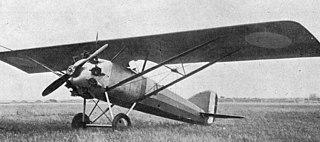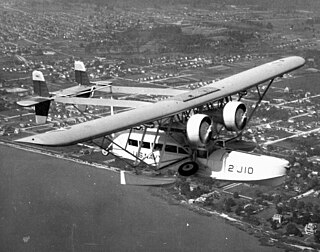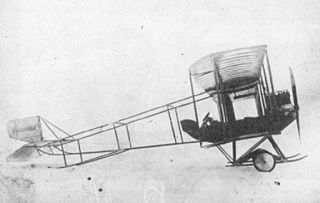
The Sikorsky S-42 was a commercial flying boat designed and built by Sikorsky Aircraft to meet requirements for a long-range flying boat laid out by Pan American World Airways in 1931. The innovative design included wing flaps, variable-pitch propellers, and a tail-carrying full-length hull. The prototype first flew on 29 March 1934, and, in the period of development and test flying that followed, quickly established ten world records for payload-to-height. The "Flying Clipper" and the "Pan Am Clipper" were other names for the S-42.

The Sikorsky S-29-A was a twin-engine sesquiplane airliner, first flown in 1924. It was the first aircraft that aviation pioneer Igor Sikorsky designed and built after coming to the United States, hence the special "-A" suffix signifying "America". The aircraft made many successful long-range flights, most of which Sikorsky piloted himself. The S-29-A claims a number of "firsts" in aviation, including the first twin-engine aircraft capable of maintaining altitude on one engine, the first aircraft to broadcast a radio musical program in-flight, in 1925 and in 1926 the first aircraft to display a motion picture in flight. The S-29-A was also one of the first aircraft to make use of an airstair door, located on the starboard side of the fuselage.

The WZ.X was the Polish reconnaissance aircraft designed in the mid-1920s and manufactured in the Centralne Warsztaty Lotnicze (CWL) - Central Aviation Workshops in Warsaw. It was the first combat aircraft of own design built in Poland, in a small series.

The PZL P.6 was a Polish fighter, designed by the engineer Zygmunt Puławski, manufactured by PZL state-owned factory. It remained a prototype and did not go into production.

The Focke-Wulf A 38 Möwe was an airliner, produced in Germany in the early 1930s. It was a final development of the family of designs that commenced with the A 17 in 1927. The A 38 used the same high-mounted, cantilever wing as the A 29, but mated this to an all-new fuselage design with enclosed seating for ten passengers and three crew. Unlike earlier members of the family, the flight deck was not joined to the cabin, separated now by a lavatory and baggage compartment. The main undercarriage was strengthened and the mainwheels fitted with brakes, while the tailskid was replaced with a tailwheel. All four A 38s were originally fitted with Siemens- or Gnome et Rhône-built Bristol Jupiter engines, but in April 1933, all aircraft were refitted with Siemens Sh 20 powerplants. By mid-1934, they had been relegated to training duties.

The Gourdou-Leseurre GL.30 was a racing aircraft built in France in 1920 which formed the basis for a highly successful family of fighter aircraft based on the same design.

The Heinkel HE 5, produced in Sweden as the Svenska Aero S 5 and nicknamed the "Hansa", was a reconnaissance floatplane built during the 1920s. It was a further development of the HE 1, sharing its same basic configuration as a low-wing, strut-braced monoplane. The HE designation also refers to the monoplane construction, standing for Heinkel Eindecker.

The Keystone K-47 Pathfinder was an airliner developed in the United States in the late 1920s, built only in prototype form.

The Sikorsky S-41 was an amphibious flying boat airliner produced in the United States in the early 1930s. Essentially a scaled-up monoplane version of the Sikorsky S-38 biplane flying boat, Pan Am operated the type on routes in the Caribbean, South America, and between Boston and Halifax.

The Sikorsky S-35 was an American triple-engined sesquiplane transport later modified to use three-engines. It was designed and built by the Sikorsky Manufacturing Company for an attempt by René Fonck on a non-stop Atlantic crossing for the Orteig Prize. It was destroyed in the attempt.

The Dyle et Bacalan DB-10 was a heavy night bomber, designed in France and flown in 1926. It was a twin engine, high wing, metal frame monoplane, distinguished by a very thick centre section wing which formed the forward fuselage and housed the engines.
The Solar MS-1 was an American prototype all-metal sesquiplane airliner built in 1930.

The Salvay-Stark Skyhopper I is a low-wing single-place homebuilt aircraft designed in 1944.

The Blériot-SPAD S.91 was a light-weight fighter aircraft by the French aircraft manufacturer Blériot.

The Sikorsky S-7 was a Russian single engine experimental prototype aircraft built by the Russian Baltic Railroad Car Works shortly after Igor Sikorsky became chief engineer of the aircraft manufacturing division.

The Sikorsky S-32 was an American single engine aircraft built by the Sikorsky Manufacturing Corporation in 1926.

The Sikorsky S-6 was a Russian single engine experimental aircraft similar to the S-5, built in 1911 by Igor Sikorsky.

The Sikorsky S-9Kruglyj was a Russian single engine prototype aircraft completed in the spring of 1913 by the Russian Baltic Railroad Car Works while Igor Sikorsky was the chief engineer of the aircraft manufacturing division.

The Sikorsky S-11 Polukroogly was a Russian single engine prototype reconnaissance aircraft completed in July 1913 by the Russian Baltic Railroad Car Works while Igor Sikorsky was the chief engineer of the aircraft manufacturing division.
The Kalinin K-6 was a mail-plane designed by Konstantin Alekseevič Kalinin. It was an aircraft largely derived from the previous Kalinin K-5, which shared its wing, tail and landing gear. This aircraft differed from the previous one by the new fuselage design, which was slender and had a four-meter compartment for the load. The K-6 flew for the first time in 1930 but remained at the prototype stage, since mass production was never authorised.




















